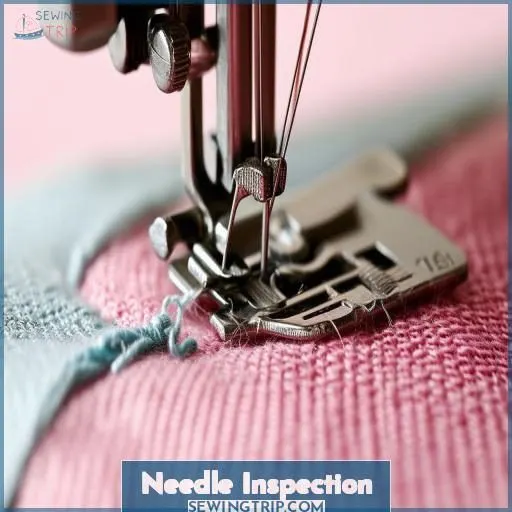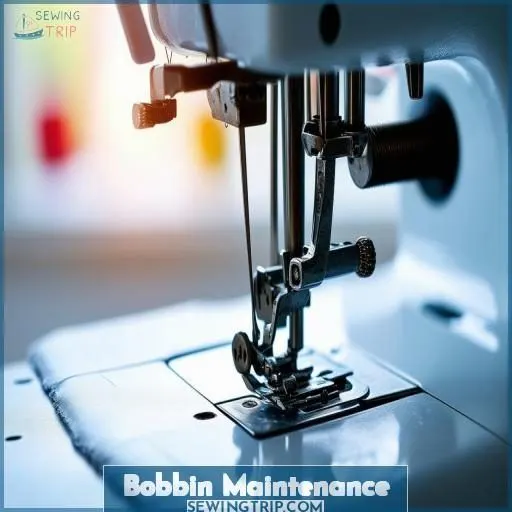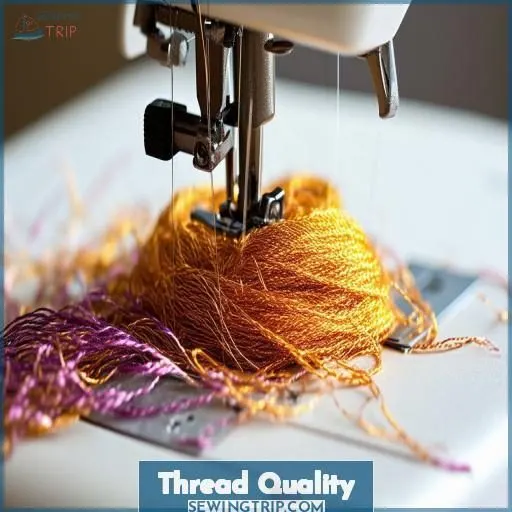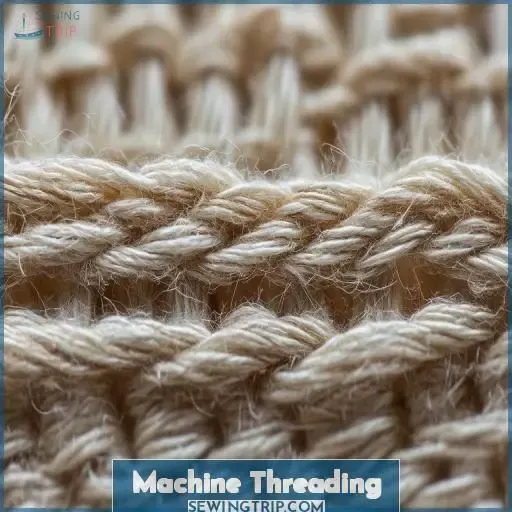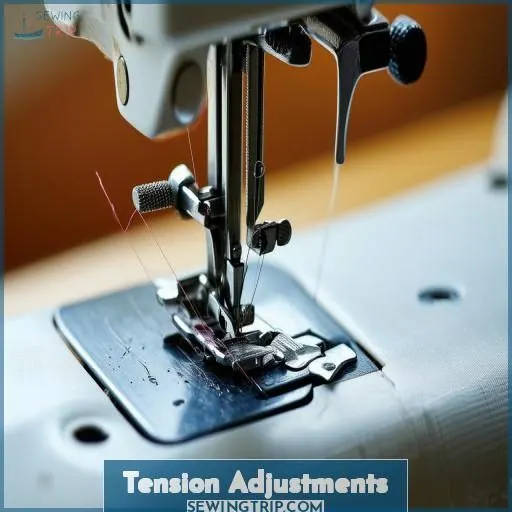This site is supported by our readers. We may earn a commission, at no cost to you, if you purchase through links.
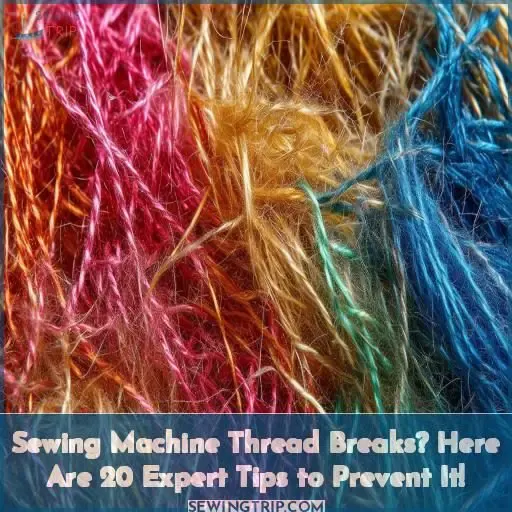 You’re sewing away, and bam! The sewing machine thread breaks, ruining your flow.
You’re sewing away, and bam! The sewing machine thread breaks, ruining your flow.
Don’t worry, you’ve got this! First, check that needle – is it the right size and type for your fabric? A dull or damaged needle can cause those pesky breaks.
Next, inspect your bobbin case and threading – any dust bunnies or uneven winding?
High-quality thread matched to your material makes a world of difference too.
Finally, those tension settings are essential – you may need to tweak them for different fabric weights.
With some troubleshooting, you’ll be back in the sewing groove, leaving thread breaks in the dust.
But if you keep running into snags, read on for more expert tips.
Table Of Contents
Key Takeaways
- Stop chasing that runaway thread like a cat after a laser pointer! The right needle for your fabric weight and type can seriously cut down on those annoying breaks.
- Your trusty bobbin may be harboring a secret stash of lint and fluff that’s sabotaging your stitches. Give it a deep clean and wind it evenly – no more tangles allowed!
- Cheap threads are the sewing machine’s kryptonite. Invest in quality thread that’s suited for your project, or you’ll be spending more time untangling knots than actually sewing.
- Don’t just blindly turn those tension knobs willy-nilly! Fine-tuning the tension settings is like finding the Goldilocks zone for your fabric – not too tight, not too loose, but just right for perfect stitches every time.
Needle Inspection
The needle is a critical component that directly interacts with the thread, so inspecting its size, type, and condition is essential. Verify that you’re using the correct needle size for the thread weight, the appropriate needle type for the fabric, and replace any dull, bent, or damaged needles to prevent skipped stitches and thread breaks.
Needle Size
Using the appropriate needle size is essential for maintaining consistent stitch quality.
Select a needle that corresponds with your thread weight – a more delicate needle for lighter threads and a larger needle for heavier threads.
Consult the needle’s packaging for size recommendations based on fabric type and thread weight.
An improperly sized needle can result in missed stitches, thread breakage, or fabric damage.
Needle Type
You’ve got the needle size down, but the type matters too. Fabric fiber, weave, and weight dictate the ideal needle. For instance:
- Stretch and knit fabrics require a ballpoint needle
- Woven fabrics call for a sharp or microtex needle
- Leather or vinyl demand a chisel or wedge needle
Using the wrong needle risks snags or perforations, compromising thread integrity. A well-matched needle glides cleanly through fabric to prevent thread breaks.
Needle Condition
Do not overlook your needle’s condition — it’s essential for smooth stitching. Always inspect for burrs around the eye that can snag thread.
Verify the needle is sharp; dull ones contribute to skipped stitches and breaks. Check for bending too; a bent needle creates uneven tension and threading issues.
If needles seem compromised, replace them immediately for desirable results. Proper needle insertion and regular replacement are sewing machine maintenance basics.
Bobbin Maintenance
A frequently overlooked cause of thread breaks is improper bobbin maintenance. You’ll want to verify the bobbin is threaded correctly, the bobbin case is clean and free of lint or debris, and the bobbin itself is wound evenly without loose threads or snags.
Bobbin Threading
Pay close attention to your bobbin – check for burrs or needle strikes in the bobbin case, inspect the tension spring and bobbin edges for roughness, guarantee a proper fit, use the correct bobbin type, and wind it evenly. Even small issues here can cause constant thread breakage, so take your time during setup.
Bobbin Case Cleaning
You’ll want to clean out any lint, fluff, or residue from the bobbin case regularly. Check for burrs or rough spots that could fray your thread. Side-less bobbins may have glue buildup, so inspect them closely. An unclean bobbin case can cause Thread tension issues, fraying, and breaks—directly impacting stitch quality.
Bobbin Winding
Proper bobbin winding is essential to prevent thread breaks.
Always use the correct bobbin type and wind it evenly, ensuring the thread distributes smoothly without tangles.
Consider using a separate bobbin-winding station for consistent tension.
For stack-wound thread, wind in the same direction as the spool. For cross-wound, wind in the opposite direction.
Mismatched thread and bobbin combinations can also contribute to breakage. Double-check compatibility with your sewing machine.
Thread Quality
You’ll want to use high-quality thread that’s appropriate for your fabric and project, as low-quality or old thread is more prone to breaks, tangles, and inconsistent tension. Storing your thread properly away from heat, moisture, and direct sunlight will also help prevent brittleness and damage that can lead to frustrating breaks.
Thread Type
You’ll also want to evaluate the thread type itself. For desired results:
- Use high-quality threads designed for machine sewing
- Match thread weight and type to your fabric
- Avoid bargain threads, which are prone to breaks
Quality thread makes a significant impact on stitch quality and reducing breaks. The appropriate thread cooperates smoothly with your machine’s tension assembly and presser foot for seamless stitching.
Thread Age
When sewing, don’t overlook thread age—dry, brittle thread breaks easily. Older thread becomes dry over time, causing snags and frays that’ll stop your machine dead. Check thread conditions before threading; discard any that seem dry or brittle to the touch. Properly storing thread away from light preserves its quality, preventing frustrating breaks mid-project.
Thread Storage
When storing thread, protect it from humidity and light exposure to prevent deterioration. Keep spools in a cool, dry area away from direct sunlight with these tips: 1) Use spool caps to prevent dust buildup, 2) Avoid storing near heat sources or windows, 3) Handle carefully to avoid snags or burrs that could lead to sewing machine thread breaks.
Machine Threading
You’ll want to inspect the thread path carefully, looking for burrs, rough edges, or anything that could catch and break the thread. Rethread the machine correctly, making sure to route the thread properly through all guides and tensioners — even small misalignments can cause breaks.
Thread Path
You need to check that the thread is traveling smoothly through the machine. Look for potential snags along the thread path – around the presser foot, needle plate, and hook mechanism. Any rough edges can catch or break the thread. Finally, check your thread tension settings, as improper tension contributes to fraying and breaks.
Thread Guides
Careful inspection of thread guides is critical. Examine for burrs, snags, or sharp edges that can fray or cut your thread. Guarantee proper thread guide placement and alignment for smooth feeding. If you notice:
- Rough surfaces
- Misaligned guides
- Worn parts
Replace or adjust them to maintain an ideal thread path through your machine.
Re-threading
Don’t just presume your threads are fine – re-threading is essential. Follow your machine’s instructions precisely, ensuring threads aren’t twisted or tangled in the guides. Even if everything seems acceptable, re-thread the bobbin when redoing the top spool. This simple step can resolve many tension troubles before they arise.
Tension Adjustments
Getting the tension right on your sewing machine is essential to prevent thread breaks. You’ll want to adjust the top tension so the bobbin thread shows slightly on the top side, while the bobbin tension should allow the needle thread to barely peek through on the bottom.
Top Tension
After double-checking your machine’s threading, adjust the top tension. Too tight, and it’ll pull the bobbin thread through. Too loose causes knots and tangles on top. Find that sweet spot:
- Increase for thicker threads/fabrics
- Decrease for thinner threads/fabrics
- Wind new thread spools smoothly
- Remove curls, knots, or snags
- Test tensions first on scrap fabric
With proper top tension settings, you’re one step closer to flawless stitches.
Bobbin Tension
If the bobbin tension is too tight, it’ll pull the top thread through to the underside. Check for burrs or rough edges inside the bobbin case that may be catching the thread. Verify that the bobbin tension spring is undamaged and the bobbin fits properly without any resistance. Adjusting the bobbin tension is essential for preventing thread breaks.
Fabric Type
Speaking of tension, consider your fabric’s characteristics.
Lightweight or loosely woven fabrics need less top tension, while dense or stretchy fabrics require more.
Texture matters too—smooth weaves glide better under the presser foot than napped or pile fabrics.
Adjust accordingly for flawless stitch quality on any textile. That level of control over fabric variables gives you freedom to experiment confidently.
Frequently Asked Questions (FAQs)
Why does my sewing machine thread keep breaking?
Your thread breaks likely due to low quality, improper threading, tension issues, or worn needles and components. Carefully inspect each part, use high-quality thread, and adjust tension to resolve.
Why does my sewing machine string keep snapping?
Your sewing thread keeps snapping likely due to tension issues, dull needles, or poor Thread quality. Check your machine’s tension settings, replace the needle regularly, and use high-quality thread to prevent frustrating breaks.
How do you prevent thread breaks?
Prevent thread breaks by using high-quality thread, correctly threading your machine, keeping components clean, adjusting tension properly, and replacing worn needles regularly. Double-check threading, inspect for burrs or snags, and confirm a smooth thread flow for a smooth sewing experience.
Why does my sewing machine thread keep shredding?
If your sewing machine thread keeps shredding, milady, it could be due to poor quality thread, burrs on the needle plate, or incorrect threading. Verily, checking your machine and using high-quality materials should solve this vexing issue.
How do different fabric types affect thread breakage?
Lightweight, slippery fabrics like silk or satin cause more thread breaks. Dense fabrics like denim or canvas increase friction leading to breaks. For knits, use ballpoint or stretch needles to prevent skipped stitches and breaks.
What role does humidity play in thread tension?
High humidity can cause thread to swell, changing tension and increasing breakage risk. You’ll want to store and use thread in a climate-controlled environment for best performance.
Can thread lubricants help prevent frequent thread breaks?
Yes, thread lubricants can prevent frequent breaks. They reduce friction, allowing smoother thread flow through guides and tensions. Apply a small amount directly to spools or cones for best results. High-quality threads often come pre-lubricated too.
Are there specific cleaning methods to reduce breakage?
You expected a flawless experience, but thread breaks happen. Ironically, thorough cleaning can minimize frustration: attentively brush lint from tension discs, bobbin area, and thread paths. Stay ahead of snags for smoother sewing.
How often should routine machine maintenance be performed?
Machine maintenance prevents issues like thread breakage. You’ll want to deeply clean your machine every 3-6 months and lubricate moving parts annually. Stay on top of everyday cleaning like removing lint and debris for best results.
Conclusion
Picture a smooth sewing session, no more fraying threads or bobbin battles. By following these 20 expert tips – from needle checks to tension tweaks – you’ll tackle sewing machine thread breaks head-on. Prioritize quality materials, diligent maintenance, and patient adjustments for foolproof stitching. With some troubleshooting finesse, those pesky sewing machine thread breaks will be a distant memory.

